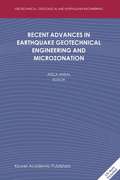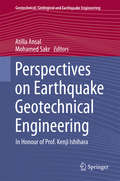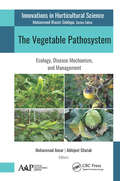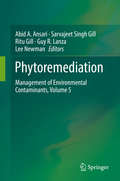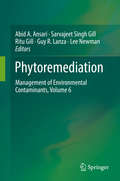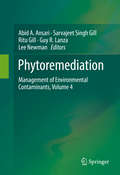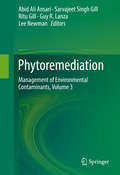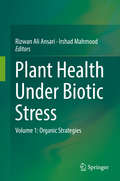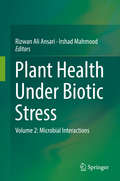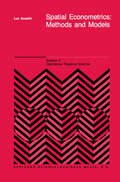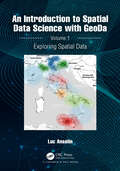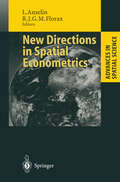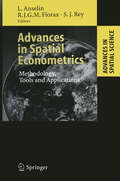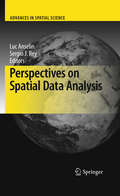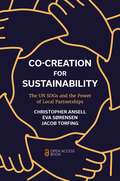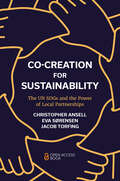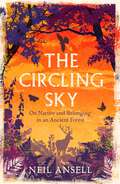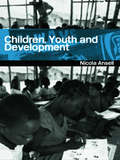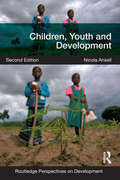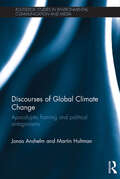- Table View
- List View
Recent Advances in Earthquake Geotechnical Engineering and Microzonation (Geotechnical, Geological and Earthquake Engineering #1)
by Atilla AnsalOutstanding advances have been achieved on Earthquake Geotechnical Engineering and Microzonation in the last decade mostly due to the increase in the recorded instrumental in-situ data and large number of case studies conducted in analyzing the observed effects during the recent major earthquakes. During the 15th International Conference on Soil Mechanics and Geotechnical Engineering held in Istanbul in August 2001, the Technical Committee of Earthquake Geotechnical Engineering, (TC4) of the International Society of Soil Mechanics and Geotechnical Engineering organised a regional seminar on Geotechnical Earthquake Engineering and Microzonation where an effort has been made to present the recent advances in the field by eminent scientists and researchers. The book idea was first suggested by the participants of this seminar. The purpose of this book as well as of the seminar was to present the broad spectrum of earthquake geotechnical engineering and seismic microzonation including strong ground motion, site characterisation, site effects, liquefaction, seismic microzonation, solid waste landfills and foundation engineering. The subject matter requires multidisciplinary input from different fields of engineering seismology, soil dynamics, geotechnical and structural engineering. The chapters in this book are prepared by some of the distinguished lecturers who took part in the seminar supplemented with contributions of few distinguished experts in the field of earthquake geotechnical engineering. The editor would like to express his gratitude to all authors for their interest and efforts in preparing their manuscripts. Without their enthusiasm and support, it would not have been possible to complete this book.
Perspectives on Earthquake Geotechnical Engineering: In Honour of Prof. Kenji Ishihara (Geotechnical, Geological and Earthquake Engineering #37)
by Atilla Ansal Mohamed SakrThis book offers a broad perspective on important topics in earthquake geotechnical engineering and gives specialists and those that are involved with research and application a more comprehensive understanding about the various topics. Consisting of eighteen chapters written by authors from the most seismic active regions of the world, such as USA, Japan, Canada, Chile, Italy, Greece, Portugal, Taiwan, and Turkey, the book reflects different views concerning how to assess and minimize earthquake damage. The authors, a prominent group of specialists in the field of earthquake geotechnical engineering, are the invited lecturers of the International Conference on Earthquake Geotechnical Engineering from Case History to Practice in the honour of Professor Kenji Ishihara held in Istanbul, Turkey during 17-19 June 2013.
The Vegetable Pathosystem: Ecology, Disease Mechanism, and Management (Innovations in Horticultural Science)
by Mohammad Ansar Abhijeet GhatakVariability in vegetable pathogens is a critical issue, particularly in changing environments, as it presents challenges to accurate diagnoses and proper management. This book focuses on the diverse ecology of phytopathogens, covering the varying disease categories (acute, chronic, and emerging), the mechanisms involved in disease development, pathogen variability, and disease management. The book also discusses the preharvest and postharvest challenges that arise due to these phytopathogens.Key Features:• Provides an overview of phytopathogens that affect vegetables in various environmental conditions• Discusses how to manage vegetables affected by specific pathogens• Offers eco-friendly approaches to prevent postharvest diseases• Presents a comprehensive guide to identifying and addressing numerous diseases for individuals in the fields of horticulture
The Vegetable Pathosystem: Ecology, Disease Mechanism, and Management (Innovations in Horticultural Science)
by Mohammad Ansar Abhijeet GhatakVariability in vegetable pathogens is a critical issue, particularly in changing environments, as it presents challenges to accurate diagnoses and proper management. This book focuses on the diverse ecology of phytopathogens, covering the varying disease categories (acute, chronic, and emerging), the mechanisms involved in disease development, pathogen variability, and disease management. The book also discusses the preharvest and postharvest challenges that arise due to these phytopathogens.Key Features:• Provides an overview of phytopathogens that affect vegetables in various environmental conditions• Discusses how to manage vegetables affected by specific pathogens• Offers eco-friendly approaches to prevent postharvest diseases• Presents a comprehensive guide to identifying and addressing numerous diseases for individuals in the fields of horticulture
Phytoremediation: Management of Environmental Contaminants, Volume 5
by Abid A. Ansari Sarvajeet Singh Gill Ritu Gill Guy R. Lanza Lee NewmanThis text details the plant-assisted remediation method, “phytoremediation”, which involves the interaction of plant roots and associated rhizospheric microorganisms for the remediation of soil contaminated with high levels of metals, pesticides, solvents, radionuclides, explosives, crude oil, organic compounds and various other contaminants. Many chapters highlight and compare the efficiency and economic advantages of phytoremediation to currently practiced soil and water treatment practices.Volume 5 of Phytoremediation: Management of Environmental Contaminants provides the capstone of the series. Taken together, the five volumes provide a broad–based global synopsis of the current applications of phytoremediation using plants and the microbial communities associated with their roots to decontaminate terrestrial and aquatic ecosystems.
Phytoremediation: Management of Environmental Contaminants, Volume 6
by Abid A. Ansari Sarvajeet Singh Gill Ritu Gill Guy R. Lanza Lee NewmanThis text details the plant-assisted remediation method, “phytoremediation”, which involves the interaction of plant roots and associated rhizospheric microorganisms for the remediation of soil contaminated with high levels of metals, metalloids, fuel and oil hydrocarbons, nano particles, pesticides, solvents, organic compounds and various other contaminants. Many chapters highlight and compare the efficiency and economic advantages of phytoremediation and nano-phytoremediation to currently practiced soil and water treatment practices.Volume 6 of Phytoremediation: Management of Environmental Contaminants continues the series. Taken together, the six volumes provide a broad–based global synopsis of the current applications of phytoremediation using plants and the microbial communities associated with their roots to decontaminate terrestrial and aquatic ecosystems.
Phytoremediation: Management of Environmental Contaminants, Volume 4
by Abid A. Ansari Sarvajeet Singh Gill Ritu Gill Guy R. Lanza Lee NewmanThis text details the plant-assisted remediation method, “phytoremediation," which involves the interaction of plant roots and associated rhizospheric microorganisms for the remediation of soil contaminated with high levels of metals, pesticides, solvents, radionuclides, explosives, crude oil, organic compounds and various other contaminants. Each chapter highlights and compares the beneficial and economical alternatives of phytoremediation to currently practiced soil removal and burial practices.
Phytoremediation: Management of Environmental Contaminants, Volume 3
by Abid Ali Ansari Sarvajeet Singh Gill Ritu Gill Guy R. Lanza Lee NewmanThis book details the plant-assisted remediation method, “phytoremediation”, which involves the interaction of plant roots and associated rhizospheric microorganisms for the remediation of soil contaminated with high levels of metals, pesticides, solvents, radionuclides, explosives, crude oil, organic compounds and various other contaminants. Each chapter highlights and compares the beneficial and economical alternatives of phytoremediation to currently practiced soil removal and burial practices.
Plant Health Under Biotic Stress: Volume 1: Organic Strategies
by Rizwan Ali Ansari Irshad MahmoodThe current scenario of increasing sensitivity towards the sustainable agriculture has given a large space to extensively utilize natural resources that are environmental friendly and are a good replacement of chemicals in agriculture. Application of organic additives in the sustainable disease management can provide new insight in sustenance of plant productivity along with improved host stress tolerance. In the present book we have focussed upon a range of organic strategies to control plant pathogens of wide spectrum in addition to maintaining robust plant health. A detailed account on the application of organic additives has been discussed, irrespective of their origin and nature. In addition, the methods of utilising these organic supplements in the management of plant diseases and promotion of plant yield in more economic way have also been presented with reference to developing, underdeveloped and developed countries. The book has included the works of eminent scholars from across the world thus flashing light on the key literature related to application of organic matters including phytoextracts, chopped leaves, composted organic manures and liquid manures in eco-friendly agriculture. The mechanisms underlying the effectiveness of these organic amendments in promoting plant health has also been presented and discussed in understandable ways.
Plant Health Under Biotic Stress: Volume 2: Microbial Interactions
by Rizwan Ali Ansari Irshad MahmoodThe book illustrates the use of putative microbial agents which provide good protection to the plant from biotic pathogens attack. An up to date knowledge on plant-microbiome interaction strategies in terms of improved sustainability has been discussed. Information from experts across the globe on the application of microbes for providing amicable solution in sustainable agriculture has been gathered. In addition, information related to microbes mediated resistance levels leading to enhanced plant health has been well presented. The chapters have emphasised the use of Plant Growth Promoting Rhizobacteria (PGPR) and other potential biocontrol agents/antagonists in the management of plant diseases which provide extensive information to the readers. Literature on microbial root colonization, plant growth promotions, and also on the protection of plants from attack of various soil borne pathogens have been presented in a coherent way. Information on the application of potential strain of the bio-control fungi, endophytes, actinomycetes strengthening the plants ability which rescue the plant from pathogens attack leading to improved plant health has also been underpinned.
Spatial Econometrics: Methods and Models (Studies in Operational Regional Science #4)
by L. AnselinSpatial econometrics deals with spatial dependence and spatial heterogeneity, critical aspects of the data used by regional scientists. These characteristics may cause standard econometric techniques to become inappropriate. In this book, I combine several recent research results to construct a comprehensive approach to the incorporation of spatial effects in econometrics. My primary focus is to demonstrate how these spatial effects can be considered as special cases of general frameworks in standard econometrics, and to outline how they necessitate a separate set of methods and techniques, encompassed within the field of spatial econometrics. My viewpoint differs from that taken in the discussion of spatial autocorrelation in spatial statistics - e.g., most recently by Cliff and Ord (1981) and Upton and Fingleton (1985) - in that I am mostly concerned with the relevance of spatial effects on model specification, estimation and other inference, in what I caIl a model-driven approach, as opposed to a data-driven approach in spatial statistics. I attempt to combine a rigorous econometric perspective with a comprehensive treatment of methodological issues in spatial analysis.
An Introduction to Spatial Data Science with GeoDa: Volume 1: Exploring Spatial Data
by Luc AnselinThis book is the first in a two-volume series that introduces the field of spatial data science. It offers an accessible overview of the methodology of exploratory spatial data analysis. It also constitutes the definitive user’s guide for the widely adopted GeoDa open-source software for spatial analysis. Leveraging a large number of real-world empirical illustrations, readers will gain an understanding of the main concepts and techniques, using dynamic graphics for thematic mapping, statistical graphing, and, most centrally, the analysis of spatial autocorrelation. Key to this analysis is the concept of local indicators of spatial association, pioneered by the author and recently extended to the analysis of multivariate data.The focus of the book is on intuitive methods to discover interesting patterns in spatial data. It offers a progression from basic data manipulation through description and exploration to the identification of clusters and outliers by means of local spatial autocorrelation analysis. A distinctive approach is to spatialize intrinsically non-spatial methods by means of linking and brushing with a range of map representations, including several that are unique to the GeoDa software. The book also represents the most in-depth treatment of local spatial autocorrelation and its visualization and interpretation by means of GeoDa.The book is intended for readers interested in going beyond simple mapping of geographical data to gain insight into interesting patterns. Some basic familiarity with statistical concepts is assumed, but no previous knowledge of GIS or mapping is required.Key Features:• Includes spatial perspectives on cluster analysis• Focuses on exploring spatial data• Supplemented by extensive support with sample data sets and examples on the GeoDaCenter websiteThis book is both useful as a reference for the software and as a text for students and researchers of spatial data science.Luc Anselin is the Founding Director of the Center for Spatial Data Science at the University of Chicago, where he is also the Stein-Freiler Distinguished Service Professor of Sociology and the College, as well as a member of the Committee on Data Science. He is the creator of the GeoDa software and an active contributor to the PySAL Python open-source software library for spatial analysis. He has written widely on topics dealing with the methodology of spatial data analysis, including his classic 1988 text on Spatial Econometrics. His work has been recognized by many awards, such as his election to the U.S. National Academy of Science and the American Academy of Arts and Science.
An Introduction to Spatial Data Science with GeoDa: Volume 1: Exploring Spatial Data
by Luc AnselinThis book is the first in a two-volume series that introduces the field of spatial data science. It offers an accessible overview of the methodology of exploratory spatial data analysis. It also constitutes the definitive user’s guide for the widely adopted GeoDa open-source software for spatial analysis. Leveraging a large number of real-world empirical illustrations, readers will gain an understanding of the main concepts and techniques, using dynamic graphics for thematic mapping, statistical graphing, and, most centrally, the analysis of spatial autocorrelation. Key to this analysis is the concept of local indicators of spatial association, pioneered by the author and recently extended to the analysis of multivariate data.The focus of the book is on intuitive methods to discover interesting patterns in spatial data. It offers a progression from basic data manipulation through description and exploration to the identification of clusters and outliers by means of local spatial autocorrelation analysis. A distinctive approach is to spatialize intrinsically non-spatial methods by means of linking and brushing with a range of map representations, including several that are unique to the GeoDa software. The book also represents the most in-depth treatment of local spatial autocorrelation and its visualization and interpretation by means of GeoDa.The book is intended for readers interested in going beyond simple mapping of geographical data to gain insight into interesting patterns. Some basic familiarity with statistical concepts is assumed, but no previous knowledge of GIS or mapping is required.Key Features:• Includes spatial perspectives on cluster analysis• Focuses on exploring spatial data• Supplemented by extensive support with sample data sets and examples on the GeoDaCenter websiteThis book is both useful as a reference for the software and as a text for students and researchers of spatial data science.Luc Anselin is the Founding Director of the Center for Spatial Data Science at the University of Chicago, where he is also the Stein-Freiler Distinguished Service Professor of Sociology and the College, as well as a member of the Committee on Data Science. He is the creator of the GeoDa software and an active contributor to the PySAL Python open-source software library for spatial analysis. He has written widely on topics dealing with the methodology of spatial data analysis, including his classic 1988 text on Spatial Econometrics. His work has been recognized by many awards, such as his election to the U.S. National Academy of Science and the American Academy of Arts and Science.
New Directions in Spatial Econometrics (Advances in Spatial Science)
by Luc Anselin Raymond FloraxThe promising new directions for research and applications described here include alternative model specifications, estimators and tests for regression models and new perspectives on dealing with spatial effects in models with limited dependent variables and space-time data.
Advances in Spatial Econometrics: Methodology, Tools and Applications (Advances in Spatial Science)
by Luc Anselin Raymond Florax Sergio J. ReyWorld-renowned experts in spatial statistics and spatial econometrics present the latest advances in specification and estimation of spatial econometric models. This includes information on the development of tools and software, and various applications. The text introduces new tests and estimators for spatial regression models, including discrete choice and simultaneous equation models. The performance of techniques is demonstrated through simulation results and a wide array of applications related to economic growth, international trade, knowledge externalities, population-employment dynamics, urban crime, land use, and environmental issues. An exciting new text for academics with a theoretical interest in spatial statistics and econometrics, and for practitioners looking for modern and up-to-date techniques.
Perspectives on Spatial Data Analysis: Perspectives On Spatial Data Analysis (Advances in Spatial Science)
by Luc Anselin Sergio J. ReySpatial data analysis has seen explosive growth in recent years. Both in mainstream statistics and econometrics as well as in many applied ?elds, the attention to space, location, and interaction has become an important feature of scholarly work. The methodsdevelopedto dealwith problemsofspatialpatternrecognition,spatialau- correlation, and spatial heterogeneity have seen greatly increased adoption, in part due to the availability of user friendlydesktopsoftware. Throughhis theoretical and appliedwork,ArthurGetishasbeena majorcontributing?gureinthisdevelopment. In this volume, we take both a retrospective and a prospective view of the ?eld. We use the occasion of the retirement and move to emeritus status of Arthur Getis to highlight the contributions of his work. In addition, we aim to place it into perspective in light of the current state of the art and future directions in spatial data analysis. To this end, we elected to combine reprints of selected classic contributions by Getiswithchapterswrittenbykeyspatialscientists.Thesescholarswerespeci?cally invited to react to the earlier work by Getis with an eye toward assessing its impact, tracing out the evolution of related research, and to re?ect on the future broadening of spatial analysis. The organizationof the book follows four main themes in Getis’ contributions: • Spatial analysis • Pattern analysis • Local statistics • Applications For each of these themes, the chapters provide a historical perspective on early methodological developments and theoretical insights, assessments of these c- tributions in light of the current state of the art, as well as descriptions of new techniques and applications.
Co-Creation for Sustainability: The UN SDGs and the Power of Local Partnerships
by Christopher Ansell Eva Sørensen Jacob TorfingThe ebook edition of this title is Open Access and freely available to read online. The UN’s Sustainable Development Goals (SDGs) set an ambitious agenda for global problem-solving and create a framework to achieve it through the power of partnerships. Goal 17 points to the central importance of partnerships, networks, and multi-stakeholder collaborations for bringing together a broad range of actors to accomplish the first 16 goals. Only through such partnerships can the distributed knowledge, resources and capacity of government agencies, private enterprises, political activists, local communities, and international NGOs be effectively combined to produce the major breakthroughs in sustainability that the SDGs envision. Co-Creation for Sustainability sets out a strategy of partnership, with an emphasis on how global goals can be translated into local action. Co-creation brings multiple parties together—including citizens—to collaboratively engage in innovative problem-solving. The book explains this strategy and describes how to foster the conditions necessary for its success. It details how leaders can spur co-creation and manage and overcome its practical challenges. Written to inspire public and private changemakers to find fundamental solutions to the pressing challenges that confront our social and natural environment, Co-creation for Sustainability: The UN SDGs and the Power of Partnerships provides intellectual resources and practical advice relevant for those who aspire to harness the talents, energy and perspectives of different sectors to build the momentum we need to realize a sustainable future.
Co-Creation for Sustainability: The UN SDGs and the Power of Local Partnerships
by Christopher Ansell Eva Sørensen Jacob TorfingThe ebook edition of this title is Open Access and freely available to read online. The UN’s Sustainable Development Goals (SDGs) set an ambitious agenda for global problem-solving and create a framework to achieve it through the power of partnerships. Goal 17 points to the central importance of partnerships, networks, and multi-stakeholder collaborations for bringing together a broad range of actors to accomplish the first 16 goals. Only through such partnerships can the distributed knowledge, resources and capacity of government agencies, private enterprises, political activists, local communities, and international NGOs be effectively combined to produce the major breakthroughs in sustainability that the SDGs envision. Co-Creation for Sustainability sets out a strategy of partnership, with an emphasis on how global goals can be translated into local action. Co-creation brings multiple parties together—including citizens—to collaboratively engage in innovative problem-solving. The book explains this strategy and describes how to foster the conditions necessary for its success. It details how leaders can spur co-creation and manage and overcome its practical challenges. Written to inspire public and private changemakers to find fundamental solutions to the pressing challenges that confront our social and natural environment, Co-creation for Sustainability: The UN SDGs and the Power of Partnerships provides intellectual resources and practical advice relevant for those who aspire to harness the talents, energy and perspectives of different sectors to build the momentum we need to realize a sustainable future.
The Circling Sky: On Nature and Belonging in an Ancient Forest
by Neil AnsellFrom a 2018 Wainwright Prize shortlisted author, THE CIRCLING SKY is part childhood memoir, blended with exquisite nature observation, and the story of one man's journey over a year to one of the UK's key natural habitats, the New Forest of HampshireIn the form of several journeys, beginning in January 2019, Neil Ansell returns for solitary walks to the New Forest in Hampshire, close to where he was born. With beautiful sightings and observations of birds, trees, butterflies, insects and landscape, this is also a reflective memoir on childhood, on the history of one of the most ancient and important natural habitats in the United Kingdom, and on the Gypsies who lived there for centuries - and were subsequently expelled to neighbouring cities. It is also part polemic on our collective and individual responsibility for the land and world in which we live, and how we care for it. As Neil Ansell concludes so eloquently, 'Evolution has no choice in what it does, but we do, as a species, if not always as individuals'.
Children, Youth and Development
by Nicola AnsellChildren constitute a large part of the population of developing countries. Throughout the developing world, experiences of childhood are extremely diverse, both between places and between children in particular places, from the international level through to the different treatment of a boy and a girl within the same household. This informative book considers issues such as education, child labour, street children, child soldiers, refugees, child slaves, the impact of environmental change and hazards on children and the way that children, with the enthusiasm and energy to bring about change, can be enabled to participate in 'development'.
Children, Youth and Development
by Nicola AnsellChildren constitute a large part of the population of developing countries. Throughout the developing world, experiences of childhood are extremely diverse, both between places and between children in particular places, from the international level through to the different treatment of a boy and a girl within the same household. This informative book considers issues such as education, child labour, street children, child soldiers, refugees, child slaves, the impact of environmental change and hazards on children and the way that children, with the enthusiasm and energy to bring about change, can be enabled to participate in 'development'.
Children, Youth and Development (Routledge Perspectives on Development)
by Nicola AnsellThe new updated edition of Children, Youth and Development explores the varied ways in which global processes in the form of development policies, economic and cultural globalisation, and international agreements interact with more locally specific practices to shape the lives of young people living in the poorer regions of the world. It examines these processes, and the effects they have on young people’s lives, in relation to developing theoretical approaches to the study of children and youth.? This landmark title brings together the stock of knowledge and approaches to understanding young people’s lives in the context of development and globalization in the majority world for the first time. It introduces different theoretical approaches to the study of young people, and explores the ways in which these, along with predominantly Western conceptions of childhood and youth, have influenced how majority world children have been viewed and treated by international agencies. Contexts of globalisation and growing international inequality are explored, alongside more immediate contexts such as family and peer relationships. Chapters are devoted to groups of children deemed to be in need of protection and to debates concerning children’s rights and their participation in development projects. Young people’s health and education are considered, as is their involvement in work of various kinds, and the impacts of environmental change and hazards (including climate change). The book introduces material and concepts to readers in a very accessible way and within each chapter employs features such as boxed case studies, summaries of key ideas, discussion questions and guides to further resources. This edition has been updated to take account of significant changes in the contexts in which poor children grow up, notably the financial crisis and changing development policy environment, as well as recent theoretical developments. It is aimed at students on higher level undergraduate and postgraduate courses, as well as researchers who are unfamiliar with this area of research and practitioners in organisations working to ameliorate the lives of children in majority world countries.
Children, Youth and Development (Routledge Perspectives on Development)
by Nicola AnsellThe new updated edition of Children, Youth and Development explores the varied ways in which global processes in the form of development policies, economic and cultural globalisation, and international agreements interact with more locally specific practices to shape the lives of young people living in the poorer regions of the world. It examines these processes, and the effects they have on young people’s lives, in relation to developing theoretical approaches to the study of children and youth.? This landmark title brings together the stock of knowledge and approaches to understanding young people’s lives in the context of development and globalization in the majority world for the first time. It introduces different theoretical approaches to the study of young people, and explores the ways in which these, along with predominantly Western conceptions of childhood and youth, have influenced how majority world children have been viewed and treated by international agencies. Contexts of globalisation and growing international inequality are explored, alongside more immediate contexts such as family and peer relationships. Chapters are devoted to groups of children deemed to be in need of protection and to debates concerning children’s rights and their participation in development projects. Young people’s health and education are considered, as is their involvement in work of various kinds, and the impacts of environmental change and hazards (including climate change). The book introduces material and concepts to readers in a very accessible way and within each chapter employs features such as boxed case studies, summaries of key ideas, discussion questions and guides to further resources. This edition has been updated to take account of significant changes in the contexts in which poor children grow up, notably the financial crisis and changing development policy environment, as well as recent theoretical developments. It is aimed at students on higher level undergraduate and postgraduate courses, as well as researchers who are unfamiliar with this area of research and practitioners in organisations working to ameliorate the lives of children in majority world countries.
Discourses of Global Climate Change: Apocalyptic framing and political antagonisms (Routledge Studies in Environmental Communication and Media)
by Jonas Anshelm Martin HultmanThis book examines the arguments made by political actors in the creation of antagonistic discourses on climate change. Using in-depth empirical research from Sweden, a country considered by the international political community to be a frontrunner in tackling climate change, it draws out lessons that contribute to the worldwide environmental debate. The book identifies and analyses four globally circulated discourses that call for very different action to be taken to achieve sustainability: Industrial fatalism, Green Keynesianism, Eco-socialism and Climate scepticism. Drawing on risk society and post-political theory, it elaborates concepts such as industrial modern masculinity and ecomodern utopia, exploring how it is possible to reconcile apocalyptic framing to the dominant discourse of political conservatism. This highly original and detailed study focuses on opinion leaders and the way discourses are framed in the climate change debate, making it valuable reading for students and scholars of environmental communication and media, global environmental policy, energy research and sustainability.
Discourses of Global Climate Change: Apocalyptic framing and political antagonisms (Routledge Studies in Environmental Communication and Media)
by Jonas Anshelm Martin HultmanThis book examines the arguments made by political actors in the creation of antagonistic discourses on climate change. Using in-depth empirical research from Sweden, a country considered by the international political community to be a frontrunner in tackling climate change, it draws out lessons that contribute to the worldwide environmental debate. The book identifies and analyses four globally circulated discourses that call for very different action to be taken to achieve sustainability: Industrial fatalism, Green Keynesianism, Eco-socialism and Climate scepticism. Drawing on risk society and post-political theory, it elaborates concepts such as industrial modern masculinity and ecomodern utopia, exploring how it is possible to reconcile apocalyptic framing to the dominant discourse of political conservatism. This highly original and detailed study focuses on opinion leaders and the way discourses are framed in the climate change debate, making it valuable reading for students and scholars of environmental communication and media, global environmental policy, energy research and sustainability.
